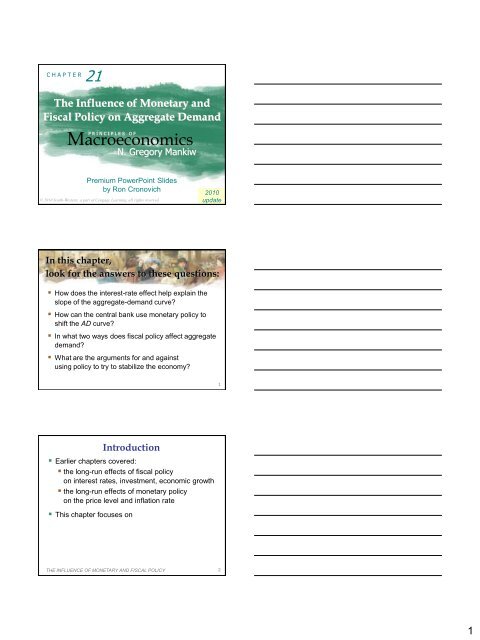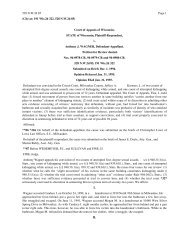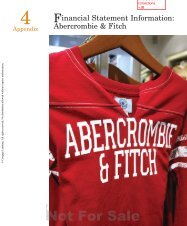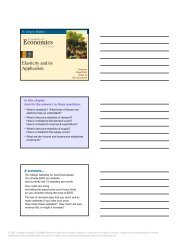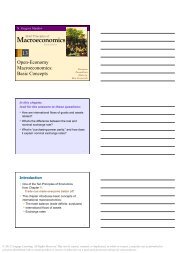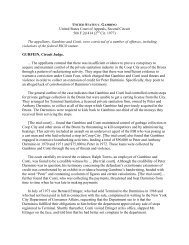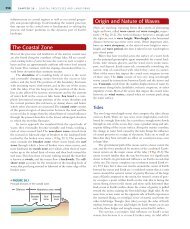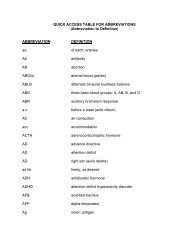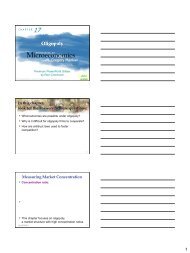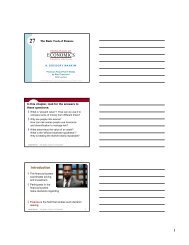Macroeconomics - Cengage Learning
Macroeconomics - Cengage Learning
Macroeconomics - Cengage Learning
Create successful ePaper yourself
Turn your PDF publications into a flip-book with our unique Google optimized e-Paper software.
C H A P T E R<br />
21<br />
The Influence of Monetary and<br />
Fiscal Policy on Aggregate Demand<br />
P R I N C I P L E S O F<br />
<strong>Macroeconomics</strong><br />
N. Gregory Mankiw<br />
Premium PowerPoint Slides<br />
by Ron Cronovich<br />
© 2010 South-Western, a part of <strong>Cengage</strong> <strong>Learning</strong>, all rights reserved<br />
2010<br />
update<br />
In this chapter,<br />
look for the answers to these questions:<br />
How does the interest-rate effect help explain the<br />
slope of the aggregate-demand curve?<br />
How can the central bank use monetary policy to<br />
shift the AD curve?<br />
In what two ways does fiscal policy affect aggregate<br />
demand?<br />
What are the arguments for and against<br />
using policy to try to stabilize the economy?<br />
Introduction<br />
Earlier chapters covered:<br />
the long-run effects of fiscal policy<br />
on interest rates, investment, economic growth<br />
the long-run effects of monetary policy<br />
on the price level and inflation rate<br />
This chapter focuses on<br />
THE INFLUENCE OF MONETARY AND FISCAL POLICY<br />
1<br />
2<br />
1
Aggregate Demand<br />
Recall, the AD curve slopes downward for three<br />
reasons:<br />
The wealth effect<br />
The interest-rate effect<br />
The exchange-rate effect<br />
Next:<br />
A supply-demand model that helps explain the<br />
interest-rate effect and how monetary policy<br />
affects aggregate demand.<br />
THE INFLUENCE OF MONETARY AND FISCAL POLICY<br />
The Theory of Liquidity Preference<br />
A simple theory of the interest rate (denoted r)<br />
r adjusts to balance<br />
Money supply:<br />
THE INFLUENCE OF MONETARY AND FISCAL POLICY<br />
The Theory of Liquidity Preference<br />
Money demand<br />
For simplicity, suppose household wealth<br />
includes only two assets:<br />
Money – liquid but pays no interest<br />
Bonds – pay interest but not as liquid<br />
A household’s “money demand” reflects its<br />
preference for liquidity.<br />
The variables that influence money demand:<br />
THE INFLUENCE OF MONETARY AND FISCAL POLICY<br />
3<br />
4<br />
5<br />
2
Money Demand<br />
Suppose real income (Y) rises. Other things<br />
equal, what happens to money demand?<br />
If Y rises:<br />
I.e., an increase in Y causes an increase in<br />
money demand, other things equal.<br />
THE INFLUENCE OF MONETARY AND FISCAL POLICY<br />
A C T I V E L E A R N I N G 1<br />
The determinants of money demand<br />
A. Suppose r rises, but Y and P are unchanged.<br />
What happens to money demand?<br />
B. Suppose P rises, but Y and r are unchanged.<br />
What happens to money demand?<br />
A C T I V E L E A R N I N G 1<br />
Answers<br />
6<br />
7<br />
8<br />
3
Interest<br />
rate<br />
THE INFLUENCE OF MONETARY AND FISCAL POLICY<br />
Interest<br />
rate<br />
How r Is Determined<br />
M<br />
MS curve<br />
MD curve<br />
How the Interest-Rate Effect Works<br />
r 1<br />
MS<br />
MD 1<br />
THE INFLUENCE OF MONETARY AND FISCAL POLICY<br />
M<br />
P<br />
AD<br />
Monetary Policy and Aggregate Demand<br />
To achieve macroeconomic goals, the Fed can<br />
use monetary policy to<br />
P 1<br />
P 2<br />
The Fed’s policy instrument is<br />
The news often reports that the Fed targets the<br />
interest rate.<br />
More precisely,<br />
To change the interest rate<br />
THE INFLUENCE OF MONETARY AND FISCAL POLICY<br />
Y 1<br />
Y<br />
10<br />
11<br />
12<br />
4
The Effects of Reducing the Money Supply<br />
Interest<br />
rate<br />
r 1<br />
MS 1<br />
MD<br />
THE INFLUENCE OF MONETARY AND FISCAL POLICY<br />
M<br />
A C T I V E L E A R N I N G 2<br />
Monetary policy<br />
For each of the events below,<br />
- determine the short-run effects on output<br />
- determine how the Fed should adjust the money<br />
supply and interest rates to stabilize output<br />
A. Congress tries to balance the budget by cutting<br />
govt spending.<br />
B. A stock market boom increases household<br />
wealth.<br />
P 1<br />
C. War breaks out in the Middle East,<br />
causing oil prices to soar.<br />
A C T I V E L E A R N I N G 2<br />
Answers<br />
P<br />
Y 1<br />
AD 1<br />
Y<br />
13<br />
14<br />
15<br />
5
Fiscal Policy and Aggregate Demand<br />
Fiscal policy:<br />
Expansionary fiscal policy<br />
Contractionary fiscal policy<br />
Fiscal policy has two effects on AD...<br />
THE INFLUENCE OF MONETARY AND FISCAL POLICY<br />
1. The Multiplier Effect<br />
If the govt buys $20b of planes from Boeing,<br />
Boeing’s revenue increases by $20b.<br />
This is distributed to Boeing’s workers (as wages)<br />
and owners (as profits or stock dividends).<br />
These people are also consumers<br />
Multiplier effect:<br />
THE INFLUENCE OF MONETARY AND FISCAL POLICY<br />
A $20b increase in G<br />
initially shifts AD<br />
to the right by $20b.<br />
The increase in Y<br />
causes<br />
1. The Multiplier Effect<br />
P 1<br />
THE INFLUENCE OF MONETARY AND FISCAL POLICY<br />
P<br />
AD 1<br />
Y 1<br />
Y<br />
18<br />
19<br />
20<br />
6
Marginal Propensity to Consume<br />
How big is the multiplier effect?<br />
It depends on<br />
Marginal propensity to consume (MPC):<br />
E.g., if MPC = 0.8 and income rises $100,<br />
C rises $________<br />
THE INFLUENCE OF MONETARY AND FISCAL POLICY<br />
A Formula for the Multiplier<br />
Notation: G is the change in G,<br />
Y and C are the ultimate changes in Y and C<br />
Y = C + I + G + NX identity<br />
THE INFLUENCE OF MONETARY AND FISCAL POLICY<br />
I and NX do not change<br />
because C = MPC Y<br />
solved for Y<br />
A Formula for the Multiplier<br />
The size of the multiplier depends on MPC.<br />
E.g., if MPC = 0.5 multiplier =<br />
if MPC = 0.75 multiplier =<br />
if MPC = 0.9 multiplier =<br />
1<br />
Y = G<br />
1 – MPC<br />
The multiplier<br />
THE INFLUENCE OF MONETARY AND FISCAL POLICY<br />
A bigger MPC means<br />
21<br />
22<br />
23<br />
7
Other Applications of the Multiplier Effect<br />
The multiplier effect:<br />
Each $1 increase in G can generate<br />
more than a $1 increase in agg demand.<br />
Also true for the other components of GDP.<br />
Example:<br />
THE INFLUENCE OF MONETARY AND FISCAL POLICY<br />
2. The Crowding-Out Effect<br />
Fiscal policy has another effect on AD<br />
that works in the opposite direction.<br />
A fiscal expansion raises r,<br />
So, the size of the AD shift may be ___________<br />
than the initial fiscal expansion.<br />
This is called the crowding-out effect.<br />
THE INFLUENCE OF MONETARY AND FISCAL POLICY<br />
How the Crowding-Out Effect Works<br />
Interest<br />
rate<br />
A $20b increase in G<br />
r 1<br />
MS<br />
MD 1<br />
THE INFLUENCE OF MONETARY AND FISCAL POLICY<br />
M<br />
P 1<br />
P<br />
AD 1<br />
Y 1<br />
Y<br />
24<br />
25<br />
26<br />
8
Changes in Taxes<br />
A tax cut increases households’ take-home pay.<br />
Households<br />
The size of the shift is affected by the multiplier<br />
and crowding-out effects.<br />
Another factor: whether households perceive the<br />
tax cut to be<br />
THE INFLUENCE OF MONETARY AND FISCAL POLICY<br />
A C T I V E L E A R N I N G 3<br />
Exercise<br />
The economy is in recession.<br />
Shifting the AD curve rightward by $200b<br />
would end the recession.<br />
A. If MPC = .8 and there is no crowding out,<br />
how much should Congress increase G<br />
to end the recession?<br />
B. If there is crowding out, will Congress need to<br />
increase G more or less than this amount?<br />
A C T I V E L E A R N I N G 3<br />
Answers<br />
27<br />
28<br />
29<br />
9
Fiscal Policy and Aggregate Supply<br />
Most economists believe the short-run effects of<br />
fiscal policy mainly work through agg demand.<br />
But<br />
Recall one of the Ten Principles from Chap 1:<br />
People respond to incentives.<br />
<br />
People who believe this effect is large are called<br />
THE INFLUENCE OF MONETARY AND FISCAL POLICY<br />
Fiscal Policy and Aggregate Supply<br />
Govt purchases might affect agg supply.<br />
Example:<br />
This effect is probably more relevant in the long<br />
run: it takes time to build the new roads and put<br />
them into use.<br />
THE INFLUENCE OF MONETARY AND FISCAL POLICY<br />
Using Policy to Stabilize the Economy<br />
Since the Employment Act of 1946, economic<br />
stabilization has been a goal of U.S. policy.<br />
Economists debate how active a role the govt<br />
should take to stabilize the economy.<br />
THE INFLUENCE OF MONETARY AND FISCAL POLICY<br />
31<br />
32<br />
33<br />
10
The Case for Active Stabilization Policy<br />
Keynes:<br />
among households and firms, leading to shifts in<br />
aggregate demand and fluctuations in output and<br />
employment.<br />
Also, other factors cause fluctuations, e.g.,<br />
If policymakers do nothing, these fluctuations are<br />
destabilizing to businesses, workers, consumers.<br />
THE INFLUENCE OF MONETARY AND FISCAL POLICY<br />
The Case for Active Stabilization Policy<br />
Proponents of active stabilization policy<br />
believe the govt should use policy<br />
to reduce these fluctuations:<br />
When GDP falls below its natural rate,<br />
When GDP rises above its natural rate,<br />
THE INFLUENCE OF MONETARY AND FISCAL POLICY<br />
Keynesians in the White House<br />
1961:<br />
John F Kennedy pushed for a<br />
tax cut to stimulate agg demand.<br />
Several of his economic advisors<br />
were followers of Keynes.<br />
2001:<br />
George W Bush pushed for a<br />
tax cut that helped the economy<br />
recover from a recession that<br />
had just begun.<br />
THE INFLUENCE OF MONETARY AND FISCAL POLICY<br />
34<br />
35<br />
36<br />
11
The Case Against Active Stabilization Policy<br />
Monetary policy<br />
Firms make investment plans in advance,<br />
so<br />
Most economists believe it takes at least<br />
____________ for mon policy to affect output<br />
and employment.<br />
Fiscal policy<br />
Changes in G and T require Acts of Congress.<br />
The legislative process can take months or<br />
years.<br />
THE INFLUENCE OF MONETARY AND FISCAL POLICY<br />
The Case Against Active Stabilization Policy<br />
Due to these long lags, critics of active policy<br />
argue that<br />
These critics contend that policymakers should<br />
focus on long-run goals like economic growth<br />
and low inflation.<br />
THE INFLUENCE OF MONETARY AND FISCAL POLICY<br />
Automatic Stabilizers<br />
Automatic stabilizers:<br />
THE INFLUENCE OF MONETARY AND FISCAL POLICY<br />
37<br />
38<br />
39<br />
12
Automatic Stabilizers: Examples<br />
The tax system<br />
Govt spending<br />
<br />
Govt spending on these programs automatically<br />
rises, which stimulates agg demand.<br />
THE INFLUENCE OF MONETARY AND FISCAL POLICY<br />
CONCLUSION<br />
Policymakers need to consider all the effects of<br />
their actions. For example,<br />
When Congress cuts taxes, it should consider<br />
When the Fed reduces the rate of money<br />
growth, it must take into account not only<br />
THE INFLUENCE OF MONETARY AND FISCAL POLICY<br />
40<br />
41<br />
13


